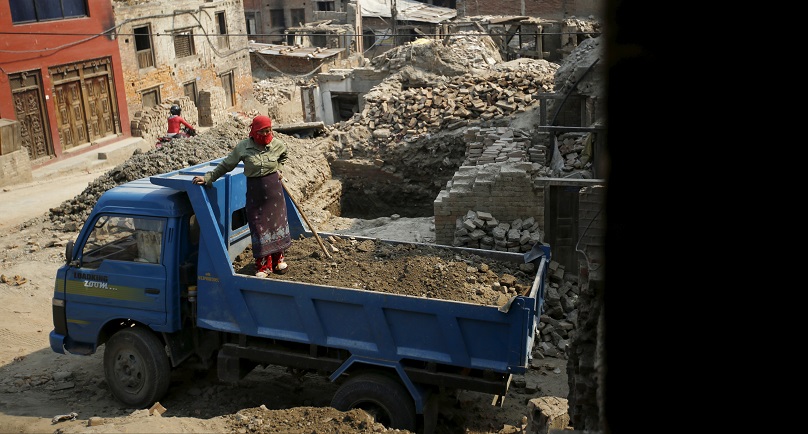Image: A woman stands on top of debris cleared from a collapsed house a year after the 2015 earthquakes in Bhaktapur, Nepal, April 25, 2016. REUTERS/Navesh Chitrakar/Files
![]()
By Gopal Sharma
KATHMANDU (Thomson Reuters Foundation) – For weeks after Nepal’s worst earthquake in 80 years, the skies above the Himalayan nation vibrated with military helicopters ferrying relief, airplanes bringing in aid workers, and drones.
When the 7.8 magnitude quake struck Nepal in April 2015, flattening homes and killing thousands of people, authorities scrambled to assess the damage and deliver relief to survivors.
Within hours foreign governments and aid agencies had heeded the overwhelmed Nepali government’s appeal for assistance, sending everything from medical equipment to plastic sheets, food rations and clean water.
They also sent drones.
Long associated with conflicts where they have been deployed in air strikes and for intelligence or surveillance purposes, the use of Unmanned Aerial Vehicles (UAVs) is rising in other areas, including response to natural disasters.
In Nepal, several agencies used them for search and rescue missions and to map out toppled monuments, ruined heritage sites and devastated homes.
The International Organization for Migration has been using drones since 2012 to capture the damage in Haiti after its 2010 earthquake.
Drones were again used in the Philippines after Typhoon Haiyan in 2013 as a tool for reconstruction efforts, and are now being deployed there to find out where farmland is most at risk from natural disasters, and to assess their impact.
In 2014, Medecins Sans Frontieres piloted the use of drones to deliver vaccines and medicine in Papua New Guinea, while the International Organization trialled a similar programme in Bhutan, researchers said.
“The beauty of drones is that they are cheap, easy to use and people can be taught to use them quickly, so there is no need for foreign aid workers to parachute into disaster zones,” said Faine Greenwood, research assistant on drones at the Harvard Humanitarian Initiative.
AN ADDED BURDEN?
With an ability to produce 3-D maps that are often more detailed than satellite imagery, drones can rapidly provide valuable information on the humanitarian needs of survivors.
While supporters of the technology hail its potential to revolutionise humanitarian work, industry experts warn of the security, ethical and legal concerns it raises for agencies and governments. For example in Nepal, media reports of drones flying near security installations stoked fears the footage could be misused.
Nepal had no regulations on drones when disaster struck, leading to confusion within the government and aid agencies on how they should use the technology, said Patrick Meier, founder of humanitarian UAV network UAViators.
Such problems are the impetus behind a global code of conduct for using drones in aid that Meier hopes to launch at the World Humanitarian Summit in Istanbul later this month.
After the Nepal quake, the authorities said unregulated drones were an extra headache for an overstretched government already under fire for its slow and inadequate response to the disaster.
“Drones were an added burden for us,” Yadav Koirala, a senior official with Nepal’s Home Ministry, told the Thomson Reuters Foundation. “There was no restriction on them.”
“They flew everywhere but offered no feedback to the government. It was difficult to control them,” he said.
As a result, the Civil Aviation Authority of Nepal banned UAVs from flying without its permission, restricted flying time to 15 minutes and introduced no-fly zones over houses, security agency buildings and religious or cultural heritage sites.
It also stipulated that drones could only be used 300 metres from the pilot, and at a maximum flight height of 100 metres.
Nama Raj Budhathoki, executive director of Kathmandu Living Labs (KLL), a tech company that is exploring the possible uses of UAVs in its “Drones for Good” project, said Nepal should not discourage the use of drones in humanitarian relief with tighter regulatory measures.
“Practical regulations should be in place to monitor them and encourage the development of the technology for good purposes,” said Budhathoki, who believes drones can enhance disaster preparedness and response in Nepal, a country prone to floods, landslides and avalanches.
THE FUTURE FOR DRONES
UAViators’ Meier called for regulations on the use of drones in crises and better coordination between those involved in the response.
“It’s not rocket science; it worked well in Vanuatu last year (after Cyclone Pam), where there was great collaboration between the military, government, aid agencies, air traffic control,” he told the Thomson Reuters Foundation by phone from Washington.
Aid agencies should train local people to use drones, and engage with communities to inform them about UAVs and ensure they are comfortable with it, said Greenwood from the Harvard Humanitarian Initiative.
“Imagine someone who has already been traumatised and suddenly an aid worker is flying a drone around – that could be disturbing and alienating,” she said by phone from Boston.
While drones are currently used to capture photos and videos and map out areas hit by disasters or conflict, their ability to drop supplies to hard-to-reach areas is being tested worldwide.
Yet Greenwood believes that drone delivery is a long way off.
“The technology is possible, but I don’t think it is the most compelling use of drones,” she said.
“They can’t carry a huge payload, there are air traffic issues such as avoiding aircraft, and the possibility of supplies being intercepted in conflict areas.”
For more on the World Humanitarian Summit, please visit: http://news.trust.org/spotlight/reshape-aid
(Reporting by Gopal Sharma; additional reporting by Kieran Guilbert in Dakar. Writing by Katie Nguyen. Editing by Megan Rowling. Please credit the Thomson Reuters Foundation, the charitable arm of Thomson Reuters, that covers humanitarian news, women’s rights, trafficking, corruption and climate change. Visit news.trust.org)
Copyright 2016 Thomson Reuters. Click for Restrictions.


